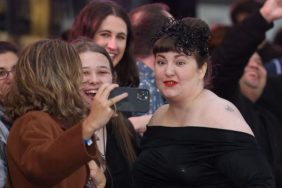I figured it must be hard remaking a classic horror film, or at least re-adapting a novel that’s been brought famously to the screen before (if you want to get into the semantics), so I got Kimberly Peirce on the phone for CraveOnline to follow up on our brief video interview and really get into the meat of her version of Carrie. The broad strokes are the same, but fans of Brian De Palma’s original 1976 interpretation of Stephen King’s debut novel doubtless noticed a slew of differences – some subtle, some very significant – and are wondering why Peirce’s version veered off in different direction.
As I mentioned to Kimberly Peirce after the “interview” part of our interview ended, I have always viewed Carrie‘s emotional power fantasy storyline as a fairy tale. She responded by saying, “That’s why you can revisit it.” True enough. Like it, love it or hate it, the story of a young, oppressed girl lashing out will live on in every interpretation, to be told again and again. Here’s why Peirce told it the way she did, from playing the tale as a superhero origin story, to the surprise guest appearance, to the unusual closing credits song, to the subtle change in motivation for the villains, to the one aspect of De Palma’s version she kept in the film, to the unexpected opening shock sequence.
MAJOR SPOILERS lie ahead.
CraveOnline: Right from scene one you make this movie your own, by opening it with Margaret White giving birth. Why was that important for you to include?
Kimberly Peirce: For two reasons. One is, when I re-read the King novel a few times, it became clear to me that I had to bring everybody as deeply inside Carrie White’s journey as possible, because I saw her as this social outcast who wanted love and acceptance, and had huge obstacles that she was up against. I knew that the success of everybody being engaged in this movie, going along for the Cinderella story but also loving the revenge tale, requires that you are inside her story. In order to do that I thought that you needed to start with what I consider the heart and soul of the movie, which is the mother/daughter relationship.
The bit with the scissors is so extreme. Were you trying to introduce the horrific elements as early as possible as well?
Absolutely. I knew that I wanted the beginning to start inside the love story, which was a feud between the protagonist and the antagonist, Carrie and her mother. I also knew that I wanted to start out in a creepy fashion. I thought, “You know what? These audiences want to be creeped out. They want to be scared.” So that was a scene that I read in the book. I did an adaptation of the scene and just put it right up front because it pulled me right into the story, and I love the fact that she has those scissors and you don’t know what she’s going to do with those scissors, you know?
I haven’t seen this scene in previous adaptations. Does this also create parallels to Sue’s pregnancy at the end of the film?
Absolutely. This is a story of creation, and the creation can bring mixed results. Mothers can love their children, they can hate their children. They can be proud of their children, they can be afraid of their children. I love that Margaret White has such an ambivalent relationship with her daughter. She thinks that maybe she’s evil. She knows that maybe she represents that Margaret had sex, and it could expose her guilt. At the same time she loves her child, and I think that’s very realistic to the true parent/child relationship. It’s very conflicted. There’s a lot of love and hate in there.
We see one other parent/child relationship in some detail: Chris’s relationship with her father. Was that Hart Bochner?
That was Hart Bochner! Isn’t he great!
He’s wonderful. It’s shorthand, because we’re so used to seeing him in films like Die Hard or Terror Train where he’s such a douchebag, and it tells you all about how entitled the Hargensen family feels.
Yes, they feel very entitled. He’s rich. He’s got it all. He’s probably out womanizing. I love Hart, and the thing about Hart is he just played it so perfectly. I think that if I had gotten the wrong actor we wouldn’t have gotten the scene right. I think that he knew that guy, and knew how to be that guy?
Do you feel that was in some way stunt-casting? That the audience was going to go, “Hey! Hart Bochner!”
Interestingly, it could have been stunt-casting but I don’t know how many people recognize him. I think it was Avy Kaufman, my casting director. As usual we were stumped, because we kept coming up with guys who were kind of silver foxes, right? They were handsome guys who were of a certain age who could get the women, and honestly there was something boring about it. They were just kind of slack. And all of a sudden Avy was like, “What about Hart Bochner?” And we all were like, “Oh my god, that’s so genius.” Because he’s handsome, he’s got that silver-haired fox, but he’s also got this… You know that this guy was a playboy in his day, and you know that that would be his daughter, and you know that she would be as entitled as he is. So they’re basically at war for who can be more entitled.
One of the more famous scenes in Brian De Palma’s film is the prom montage. You incorporated a prom montage into your version as well. Was there any temptation to try to do it differently, or is that just the best way to try to convey the build-up to a prom?
Well, I don’t know. If you want to run some other ideas I’d certainly sample them. I mean, this was me just… I looked at it, and I tried writing different versions and I played with some different ideas, and this to me got us to the prom. You know what I mean? What everybody would be basically doing, what they would be doing in a fantasy story, and… I mean look, I’m very open if there was a better idea but that’s the best idea I came up with and it seemed to work. It seems like you’re with those kids, and you can’t really spend too much time in that area.
I liked the montage. I hope I didn’t sound too critical.
No, you can be critical. I’m always looking for the better idea. I come up with the best idea I can, and make sure that it’s kind of realistic and it’s fun, and if something better comes along I’ll try that.
It’s one of the thing that interests me about Carrie, is that Carrie lives in this very repressed, dangerous, almost imprisoned world, but immediately surround her is this other, more social world of more innocent concerns. For brief periods in the film we do just get to relish in the normalcy of high school life.
Well, I think it’s really important, particularly because you’re building to what I hope is a really delicious revenge tale. You really need the normalcy so the tension can go away, and you can put your guard down and have a good time, and have it be normal and simple so that when the powers come back and when the bad girl, Chris, takes everything away from Carrie you have the emotional energy to feel bad and get angry and to say “I hope that Carrie retaliates.” So I think the normalcy is part of the tent pole of getting to the end mark.






